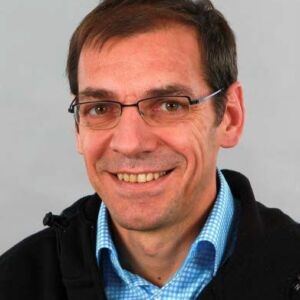Research Group Prof. Dr. sc. nat. Martin Ehrbar, Head of Research
Main Field of Research, Abstract
Development of fully synthetic modular designed biomaterials. Although naturally occurring biomaterials are well suitable for tissue regeneration approaches, they contain matrix inherent properties that limit their use in engineering applications. In collaboration with the laboratories of Prof. Franz Weber, University Hospital Zürich, Prof. Matthias Lütolf EPFL Lausanne and Prof. Wilfried Weber Bioss Freiburg Germany, we develop a fully synthetic hydrogel platform that can be designed towards specific matrix engineering applications in vitro and in vivo. Building blocks are developed that will allow the combination of features such as mechanical properties, proteolytic susceptibility, integrin binding, and growth factor presentation within the otherwise inert poly (ethylene glycol) PEG hydrogels. Ongoing studies with this materials platform focus on: the study of cell-extracellular matrix interactions, the establishment of in vitro tissue-like constructs, the recruitment and characterization of bone precursor cells, and bone healing in vivo.
Major topics of research
- Development of adult stem cell implants: Exploration of stem / progenitor cells from human umbilical cord blood, amniotic fluid, and placenta for tissue healing applications other than hematopoietic applications. The objective is to develop cell-based therapeutics for healing of diseased cardiovascular tissue, chronic skin wounds, cartilage or bone. Transplantation of such cells may require their fixation in the treated tissue. We seek the development of implants comprised of adult stem cells in biomaterials that support engraftment and differentiation of adult stem cells.
- Healing of premature preterm rupture of the fetal membrane (PPROM). PPROM represents a devastating complication in obstetrics for which no treatment exists yet. We seek to develop implant prepared from resorbable biomatrices and human amnion cells that permit to immediately plug the leak in the ruptured membrane and guide wound healing in the following (a concept of sealing and healing). Cell biological and biochemical studies and proteomics are used to identify protein substances that will promote growth of native human amnion tissue in bioengineered healing devices.
- Development of biomaterial-protein therapeutics for biological revascularization of ischemic tissues or chronic wounds: One implant matrix from our research and development (see below), fibrin matrix formulated with covalently affixed vascular endothelial growth factor, has recently completed safety studies such that it has become approved by the ethical committee of the Kanton of Zurich for clinical studies of treatment of patients with fingertip ulcers. Ongoing studies concern tissue angiogenesis response to implants on the transcriptional level. To this end, we apply Xenogen biophotonic imaging technology and genetically engineered mice in which a luciferase reporter is driven by the promoter of the VEGF receptor 2 to non-invasively monitor the transcriptional response over weeks in the animal.
- Growth factor-loaded matrix coatings that promote prosthetic graft endothelialization. Synthetic small-diameter blood vessel replacements have a high failure rat, but early endothelialization of the lumenal surface may improve graft patency. In vivo endothelialization of synthetic grafts may be achieved by pretreatment of synthetic graft implants with angiogenic substrates that recruit endothelial cells across the anastomis, from the blood stream, or transmurally.
- Cell sheet engineering. In collaboration with the laboratory of Prof. Janos Voeros, ETH Zurich, we seek development of three-dimensionally designed composite materials consisting of cell-sheets and polymer hydrogel films for tissue engineering. The basis of the project is a new method of the Voeros laboratory at ETH Zurich that allows for the harvesting of cell sheets by electrochemical means. Such 3D cell/polymer multilayers will be used as a new platform to spatially pattern different cell types for the analysis of complex physiology in vitro and for drug screening applications. Target models are the cellular situation of an adult blood vessel, and instruction of differentiation of stem cells by enddifferentiated cells.
Yvonne Eisenegger
Alexandra Dolder
Katharina Gegenschatz
Rodi Odabasi
Simona La Cioppa
Silvia Pravato
Lukas Moser
Flurina Famos
Pietro Airaghi
Simona Scorza
Stäuble, Senta
Silvia Züger
Lisa Krattiger
Tabea Stephan
Alejandro Sancho Puchades
Ai Hsin
Epameinondas Gousopoulos
Lisa Jerabeck
Jeff Marshall
Barbara Klotz
Michela Perrini
Venkat Ramakrishnan
Mira Jacobs
Adam Korczak
Bianca Maria Carrara
Lisa Krattiger
Avilla-Royo, Eva
Ning Zhang
Vallmajo-Martin, Queralt
Blache, Ulrich
Papageorgiou, Panagio
Devaud, Yannick
Perrini, Michela
Metzger, Stéphanie
Kiveliö, Anna-Sofia
Lienemann, Philipp
Semenov, Oleg
Ajit Mallik
Avilla-Royo, Eva
Elaheh Jooybar
Vallmajo-Martin, Queralt
Katharina Gegenschatz
Riccardo Urbanet
Devaud, Yannick
Blache, Ulrich
Mirsaidi, Ali
Milleret, Vincent
Fraz Anjum
Sala-Roca, Ana
Ziogas, Algirdas
